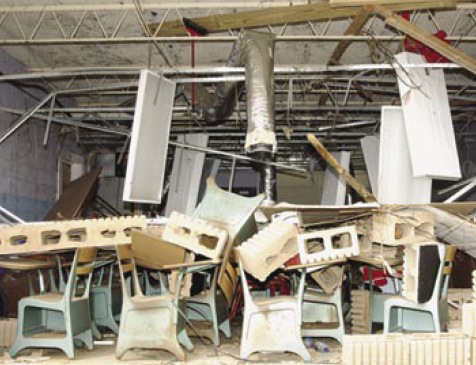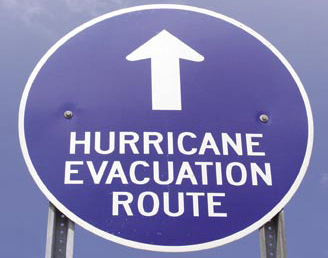In the Eye of the Storm: Hurricane Season Hits Education

Damaged library in Bay St. Louis Waveland School District, Mississippi
We all know how the wind, rain, and floods, brought first by Hurricane Katrina and then by her sister Rita, decimated schools, scattered students, and set plans for education adrift throughout the South. But few understand the storms’ toll more intimately than Sybil Wolfe, a teacher at Harrison Central Ninth Grade School in Gulfport, Mississippi, which took in students evacuated along the Gulf Coast. Wolfe said that many students made strides toward healing after the disaster by talking about their feelings in the health class she teaches.
“For the first few weeks, they were like little zombies, some of them,” said Wolfe, who was able to sympathize, having lost a home herself.
“It’s pretty much gone,” she said of the house she still owns in St. Bernard Parish, Louisiana, where she taught for 25 years before moving to Mississippi 3 years ago. Wolfe recently visited Louisiana to view the wreckage. Walls were crumbled, she said, and six inches of mud covered everything. “It was like going into a war zone, the way people must have felt going into their homes after a bombing in Europe in World War II,” she said.
Wolfe is just one of the many educators on the Gulf Coast laboring to make sense of the staggering losses and confusion that the hurricanes have meant for instruction, facilities, funding, books and computers, assessment schedules, meal programs, transportation, student records, services for students with special needs, and—something much needed at such a time—student counseling services.
Most visibly, from Mississippi to Louisiana to Texas, hundreds of school buildings were demolished or severely damaged. The first wave of destruction came in late August when Katrina slammed the coast near New Orleans and produced a storm surge that breached the city’s levee system, flooding it with water from nearby Lake Pontchartrain. The most destructive and costliest natural disaster ever to strike the United States, Katrina took more than 1,300 lives and caused damage estimated at up to $130 billion. The storm also displaced more than a million people, many of them students and school employees.
Rita struck less than a month later. More powerful than Katrina, Rita breached New Orleans levees and flooded the city’s streets again, caused $8 billion worth of damage throughout Louisiana and Texas, and claimed an additional six lives.
Although they largely escaped Hurricane Wilma, which created havoc in Florida in October, many educators directly affected by Katrina and Rita were still reeling in November. The challenges have been unprecedented. Nevertheless, as winter approached, many teachers, administrators, and education officials described a situation that was not without hope.
Classroom Impact

Louisiana Superintendent
Cecil Picard
“The hurricanes have not affected what students are taught,” said Louisiana Superintendent Cecil Picard. “We are still holding our schools and districts accountable under state policies as well as No Child Left Behind. Louisiana has a statewide comprehensive curriculum that remains in place.”
Throughout the South, such comments were typical of school officials, who insisted that students were not receiving a “watered down” curriculum, although systems had to adjust to harsh realities. “What might change—for some students in some schools—is the timing of lessons,” Picard said. Because schools shuttered for weeks by the hurricanes were running behind, he said, they would make up time by, for example, extending the school day or eliminating some holidays. The Louisiana Board of Education also raised maximum class size requirements.
Additional measures have been required, as some districts have been closed for many weeks and entire parishes, such as New Orleans and nearby St. Bernard, might not reopen before the end of the academic year. In Louisiana alone, nearly 200,000 of the state’s 730,000 students, as well as over 1,200 teachers, have been displaced. “The main effect of the additional 5,000 displaced students here has been to create overcrowded conditions in our classrooms,” said Chief Academic Officer Robert Stockwell of Louisiana’s East Baton Rouge Parish School System. “It has also required us to hold classes in some locations in auditoriums, gyms, or cafeterias.”
In Louisiana, where even before the disaster three in five students qualified for free and reduced-price lunches, teachers have observed their students suffering. “Many teachers have incorporated this tragedy into their teaching. They are still teaching the standards but are using the hurricane as a theme to do so,” said SEDL Program Associate Jill Slack, who works in Orleans Parish. For example, some teachers ask their students to express their feelings on the hurricanes in writing.

Photo of damaged school in Jackson County School District, Mississippi
Educators struggled in Mississippi too, said Debra Meibaum, another SEDL program associate, who has provided professional development and technical assistance to Mississippi schools for nearly a decade. “There’s a lot of concern about how to cover the required curriculum in the necessary timeframe and get students prepared to meet state assessment criteria,” Meibaum said.
Mississippi Superintendent of Education Hank Bounds
Compromises have been made. Mississippi Governor Haley Barbour issued a disaster declaration allowing flexibility in school management, encompassing purchasing, school accountability, enrollment, and board approval. The state board relaxed requirements for school calendars. Much further compromise was not an option, many officials said. “Students cannot afford to lose a year of instruction because of this disaster,” said Mississippi Superintendent Hank Bounds.
The surrounding states taking in the displaced students have addressed the crisis in similar ways. Alabama Superintendent Joseph Morton waived customary requirements for students who transfer due to the hurricanes. The New Mexico Public Education Department worked with UPS and Office Depot to hold a Hurricane Katrina State School Supply Drive to collect needed materials, such as pencils, scissors, and spiral notebooks. Oklahoma offered recommendations for counseling students whose painful memories of other disasters, from tornadoes to terrorist attacks in New York City and Oklahoma City, were stirred by the hurricanes. Displaced teachers were encouraged to apply for jobs in Arkansas, which expedited applications for teaching licensure. Similar efforts took shape in Florida, Georgia, Tennessee, and other states.
Texas Toughs It Out
Aside from Louisiana and Mississippi, the state arguably most affected by Hurricanes Katrina and Rita was Texas. Even as the storms uprooted students and shut down dozens of school districts within the state, Texas public schools took in some 45,000 displaced students, according to state education officials.
State leaders worked together on students’ behalf. “It is my hope that Louisiana’s seniors will be able to receive a Louisiana diploma when they graduate this spring,” said Louisiana Superintendent Cecil Picard. “We believe we can logistically work out the details so that our students can take Louisiana’s Graduation Exit Exam in Texas and their coursework can be evaluated so they meet our graduation requirements.”

To help, SEDL is providing a comparative analysis of the academic standards and assessments used by Louisiana and Texas, said SEDL Program Manager Vicki Dimock. SEDL will offer related training to Educational Service Center staff, who then can train educators in the schools they serve. It is hoped that through the analysis and training Texas educators can tailor instruction to help Louisiana students meet Texas standards embodied in state exams and Louisiana educators can better teach students returning from a temporary stay in Texas. Officials from both states are collaborating to enable students to earn credits toward graduation in the state of their choice.
The training will also focus on helping teachers and administrators recognize signs of distress and trauma and address student needs. Additionally, SEDL is developing guides for recognizing signs of distress and trauma in children and adolescents and information on how to address those symptoms and where to go for additional help.
Testing Accountability
A major concern following the hurricanes was not only how students would learn but also how they would demonstrate that learning on state tests, such as those mandated under No Child Left Behind (NCLB). By late September, U.S. Secretary of Education Margaret Spellings assuaged many worries by granting schools flexibility, saying in a congressional hearing that they must welcome displaced students with “both compassion and high expectations.”
Spellings offered two options. Under the first, Louisiana, Mississippi, Texas, Alabama, and Florida, which were declared major disaster areas, may postpone consequences such as corrective action for schools and districts that fall short of achieving Adequate Yearly Progress, or AYP, as required under NCLB. The other option permits a state to request a waiver allowing affected schools to record test scores of evacuees separately from other students, which could make accountability requirements easier to meet.
Many school systems are expected to take advantage of these options. “We are still testing all of our students on schedule this spring because we believe in accountability and want our students, schools, and districts to continue growing academically,” Picard said. Picard reported that high school students must still pass the Graduation Exit Exam to get a diploma, but he noted the high-stakes policy for fourth- and eighth-grade students has been suspended because of the impact of the hurricanes.
As in Louisiana, officials in Mississippi and other states endeavored to not only uphold high standards by maintaining their assessment programs but also collaborate across state lines to ensure that displaced students who met specific requirements could earn high school diplomas. Working through such efforts generally was viewed as less of a challenge than paying for them.
Dollars and Sense
“Local economies and tax bases for communities impacted by Hurricane Katrina have been devastated, and this in turn creates a serious financial burden on our schools,” said Bounds. “Our school funding system is based on average daily attendance in the previous school year, so school districts that have accepted large numbers of displaced students are struggling with financial issues.”
“The overriding question for all districts today is cash flow,” said Penny Dastugue, a member of the Louisiana Board of Education. “These districts are faced with unbelievable challenges in reopening their doors and taking in displaced students, and they have gotten little or no relief from the federal government.”
Eventually, proposals for federal relief abounded. The U.S. Department of Education proposed $1.9 billion for districts enrolling displaced children. Legislators proposed eliminating 14 of the department’s current programs to free up funds for relief. One bill would have permitted $15 billion in Federal Emergency Management Agency (FEMA) funding to be rerouted to schools. By early November, the Senate approved $1.66 billion for schools enrolling evacuees, offering $6,000 per regular student and $7,500 per special education student. However, these and other proposals were still awaiting approval by Congress as the urgency for relief appeared to be dissipating.
The crisis led to struggles at all levels of government. FEMA provided only partial relief by sending hundreds of portable classrooms and teams of engineers and construction experts to ravaged districts. State governments fared little better. Louisiana officials, who anticipated a state revenue shortfall of $1.5 billion, nevertheless planned to ask local school districts for enrollment information monthly to make state and federal allocations as funds were appropriated. Local governments in affected areas generally were too overwhelmed to offer meaningful relief.
Chief Business Operations Officer Catherine Fletcher of the East Baton Rouge Parish School System described the disaster’s impact on education budgets as “devastating.” Despite the relief that she says has come from public and private sources so far, Fletcher predicts that the effects will be felt for many years, largely due to the loss of a substantial portion of the New Orleans tax base.
Big Picture
Still, many education officials expressed optimism. “We do see this as a once-in-a-lifetime opportunity to rebuild schools, especially in Orleans Parish, where they were struggling financially and academically before the storms,” said Picard. “Many of our school leaders are using this opportunity to rethink their schools, and that is a positive outcome from this storm.”
All options appeared open. According to Slack, some suggested cutting bureaucracy and promoting school-level autonomy in New Orleans by replacing the centralized, top-down structure of the school system with a collection of more independent “pockets of schools.” As longstanding tensions between the state and the New Orleans school board ran high, one Louisiana legislator, Rep. Jim Tucker, was quoted in the press as saying that the state “is getting closer every day to a takeover.”
With the status quo upset by the storms, Louisiana also became a testing ground for controversial innovations such as charter schools and vouchers. Reluctant to provide tax dollars to religious schools, federal lawmakers resisted proposals to provide direct private-school vouchers for evacuees, indicating a preference for channeling funds through public school districts, which then could reimburse private schools enrolling evacuees. Meanwhile, Louisiana was awarded a $20.9 million NCLB grant in October to create charter schools, enhance existing ones, or revive those wrecked by Katrina. Later that month, in a move widely criticized for a lack of public input, the New Orleans school board approved charter school applications filed by 20 schools.
In addition to the government, the private sector became a player in rebuilding school systems. Cisco Systems, Inc., recently announced an initiative to aid Mississippi schools not only in recovering from the hurricanes but also in using technology to strengthen education. The company committed $20 million for improvements in targeted Mississippi schools, including educational technology, online curriculum materials, and professional development.
In light of such innovations, by late fall education leaders were expressing tempered optimism. “The silver lining that I have seen in all of this is how it has caused us to all join hands,” Bounds said. “If we can rebound this quickly from the worst natural disaster in our nation’s history, then we can certainly find a way to meet the needs of the boys and girls of our state.”
Sybil Wolfe, the Mississippi teacher who lost her home in Louisiana, offered a grittier appraisal of what educators could offer school-age victims of disaster. “We’re doing everything we can to get them to the point where they need to be,” she said. “We just have to dig in, pick ourselves up, and try to go on.”
Geoffrey Alan is a freelancer who writes frequently about education issues.
Next Article: Voices from the Field: The Principal's Presence and Supervision to Improve Teaching

